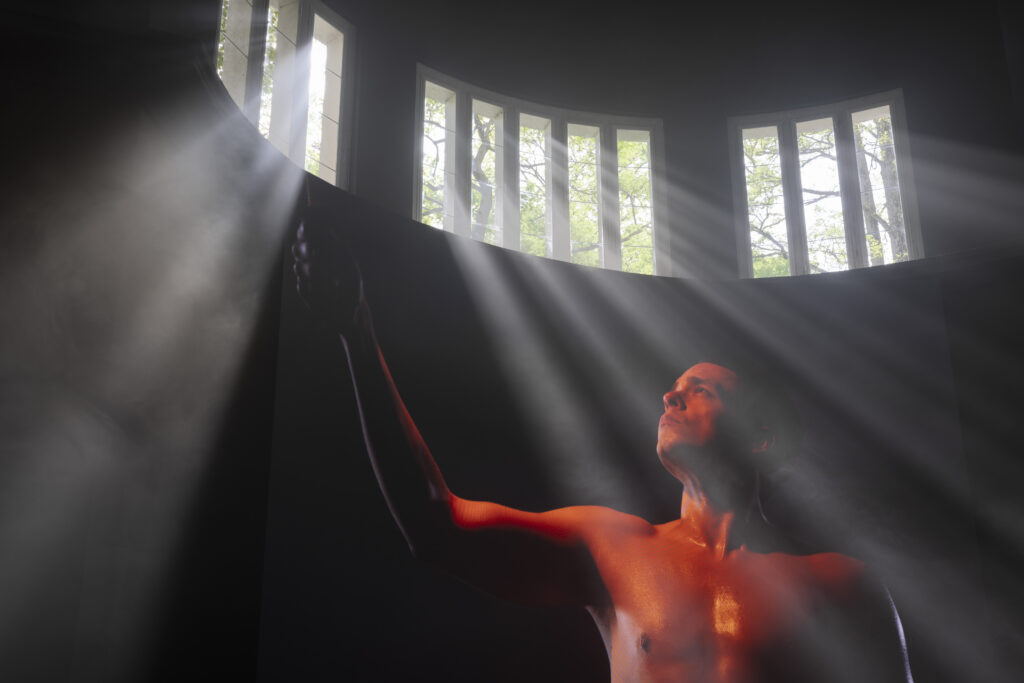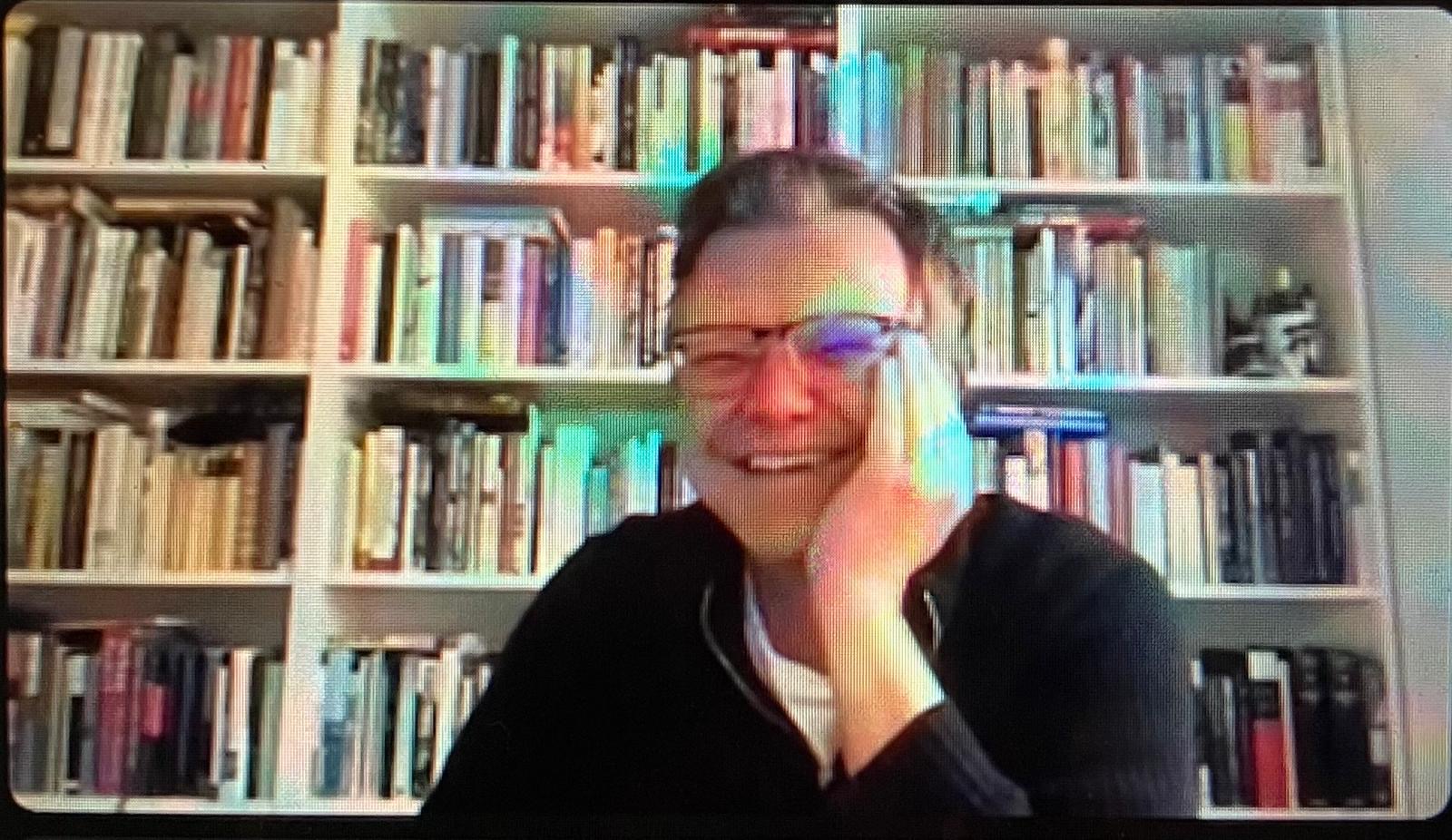Yael Bartana’s Light to the Nations, featured in the Thresholds exhibition at the German Pavilion during the 60th Venice Biennale, is a multimedia installation narrating a possible exodus from planet Earth aboard a spaceship, to ensure the survival of humanity threatened by an incumbent global catastrophe. Although it ostensibly explores universal themes of salvation and solidarity, a closer examination of the work’s narrative and conceptual references ultimately reveals how Light to the Nations reinforces supremacist ideas that echo current Israeli state policies, exposing a contradiction between the artwork’s declared intent and its actual outcome.
At the 60th edition of the Venice Biennale of Art, the German Pavilion presents a group show titled Thresholds, curated by Çağla Ilk, featuring works by Yael Bartana, Ersan Mondtag, as well as a series of sound installations on the island of La Certosa in the Venetian lagoon. As the curator explains in her statement, “[i]n a time of global crises and wars,” Thresholds aims to raise the following questions:, “What do places of solidarity look like? How can we leave behind the nation-state spatial constructs and ways of thinking?” According to Ilk, the contrast between spaces of solidarity and nation-states arises because “for many people around the world, living in the threshold between nationalities and affiliations is a traumatic and violent experience.” The exhibition therefore intends to “generate, from this experience, a position of insight and to transcend these borders for a moment.” Threshold seeks to show how boundaries dividing different human communities can be transformed into a “threshold, a place that dreams of a shared future starting from the here and now.” Representing “the dreams and stories associated with it”, the text suggests, might turn boundaries into places of connection and interaction between different human cultures.
The work exhibited by the Israeli artist Yael Bartana is a multimedia piece titled Light to the Nations. Combining science fiction and Jewish mysticism, the work narrates a possible exodus from planet Earth aboard a spaceship, to ensure the survival of humanity threatened by an incumbent global catastrophe. In describing Light to the Nations, the exhibition’s introductory text highlights that
While Light to the Nations is based on Jewish traditions, the grand endeavour transcends religious, ethnic, national, state, and tribal boundaries. It offers a future to all humanity […] The spaceship navigates beyond traditional notions of space, land, and human connection to the Earth, defying the gravitational pull and the human quest for belonging. It serves as a symbol of redemption and a physical embodiment of new societal structures, redefining humanity’s relationship with its terrestrial and territorial origins.
Light to the Nations is constructed as an epic narrative unfolding into three parts organically arranged within the spaces of the pavilion and permeating the building with an ominous atmosphere that evokes the bleak fate looming over humanity. In the first room, in a foggy environment dimly lit by hypnotic lights, resonating with bass and monotonous sounds, a large-scale reproduction of the spaceship designed for the exodus is suspended in mid-air. Its structure mirrors the diagram of the Sephirot, the ten divine emanations that, in the Kabbalistic tradition, constitute the fundamental principles of human life. The ten Sephirot here become the spheres that make up the spaceship, each housing one of the functions necessary for a human community to sustain itself during a long interstellar journey. This part of the installation reproducing the spaceship is titled Generation Ship, a name borrowed from an idea developed in early twentieth-century science fiction literature, which imagines a millennia-long journey to a new planet to be colonised, during which several generations of cosmonauts would succeed one another before reaching the final destination. In another room of the pavilion, the interior of one of the spheres of the spaceship is partially reconstructed as an immersive video installation, allowing visitors to impersonate the cosmonauts of the Generation Ship mission.

Generation Ship (Yael Bartana, 2024) as part of Light to The Nations, 2022-2024. Installation view photographed by Andrea Rossetti (courtesy of the German Pavilion at the Venice Biennale).
Moving into the main space of the pavilion, viewers encounter a monumental semicircular LED wall screening the film Farewell. It portrays the group of people selected for the Generation Ship mission as they perform a farewell ritual to the earth. They are dressed as sylphs, the ethereal beings inhabiting the air, as the German-Swiss alchemist and philosopher Paracelsus describes them in his Liber de Nymphis, Sylvanis, Pygmaeis et Salamandris et de Caeteris Spiritibus (1566), thus shifting the cultural reference from Judaism to early modern Germanic culture. The ritual takes place in a moonlit nocturnal landscape and includes elements of the Ausdruckstanz, a form of dance developed in Germany at the beginning of the twentieth century in opposition to classical ballet, therefore considered one of the origins of modern dance. The Ausdruckstanz, however, is also what has inspired the mass choreographies of totalitarian regimes. Indeed, watching through the film, it becomes evident that Farewell is a faithful reproduction of the opening scenes of Olympia, a film by Leni Riefenstahl, commissioned by the Nazi regime to document the 1936 Berlin Olympics. The first part of Olympia portrays semi-nude men and women engaged in various physical activities, intending to represent the Nazi ideal of the Aryan body.
While it may be hard to believe that the central work of the German Pavilion is a monumental tribute to a film produced under Joseph Goebbels’ supervision, the striking resemblance between Farewell and the introductory scenes of Leni Riefenstahl’s film leaves little doubt that the artist has intentionally replicated them. The groups of women and men dancing in a circle under the full moon with their arms and hands raised toward the sky and the man running towards the camera as he traverses a nocturnal landscape with a torch in hand (then portrayed from a low-angle perspective to accentuate his muscular chest) are scenes that almost perfectly overlap with those from Olympia. Moreover, the soundtrack of Farewell, which recalls the dramatic choirs of Wagner’s Götterdämmerung, further emphasises the reference to the Germanic culture of an archaic and legendary time, resulting from the combination of Paracelsus’ classicist references and Richard Wagner’s mythological imagery, on which the Nazi regime based its political aesthetics.
In a corner between two rooms of the pavilion, a small TV screen plays a video interview with art historian Doreet LeVitte Harten, with whom the artist collaborated in conceptualising the work. An expert in science fiction and Jewish mysticism, LeVitte Harten describes the theoretical, theological, and political foundations which underlie the work. Focusing on the notion of “generation ship,” a concept central to Light to the Nations, she explains how this sci-fi trope is interpreted in Yael Bartana’s work:
The particular generation ship we are discussing here is created because of the rising sea level. Tel Aviv is submerged and water gradually reaches Jerusalem. There is nowhere to live. A comet is approaching, the heat is unbearable. It’s life-threatening to the human body. This place needs to be evacuated.
Yet, if one reconsiders these words in relation to the curatorial position and especially to its intention to “leave behind nation-state spatial constructs and ways of thinking,” a fundamental ambiguity underpinning Yael Bartana’s work emerges. By confining Light to the Nations’ narrative to the Israeli state’s borders, the nation-state appears not as an agent that is left behind, as per the curator’s statement, but rather as humanity’s saviour. This point becomes even clearer in the following part of the interview, where LeVitte Harten stresses that:
We are talking about a Jewish spaceship here. But in the face of a cataclysm, this will not be the only spaceship. It is likely that each superpower will launch its own Generation Ship, in an attempt to save people of its culture, religion, and heritage.
LeVitte Harten’s idea is therefore that such interstellar expeditions would be conducted by various superpowers to safeguard exclusively the specific ethnic, cultural, and religious community with which each superpower identifies. This idea renders Light to the Nations a story of how the Israeli superpower would attempt to save the “people of its culture, religion, and heritage” from the catastrophe. Analysing Light to the Nations in the terms laid out by its ideational collaborator, rather than as per universalistic references to humanity’s salvation, makes evident the work’s alignment with the specific identarian ideology that characterises current Israeli state policies: “Israel is the nation-state of the Jewish people” declares the Basic Law passed by the Knesset in 2018. This identification between the Israeli state and the Jewish people, as noted by various international organisations, such as the European Commission, necessarily excludes non-Jewish communities from their right to citizenship—an ideological stance that Light to the Nations seems to fully integrate in its narrative.
The film Farewell joins LeVitte Harten’s words in contradicting the objectives laid out by Thresholds’ curatorial statement. The participants of the Generation Ship mission represented in the film consist of an exclusively Caucasian cast, thus reinforcing the political framework outlined by LeVitte Harten and excluding the majority of the world’s population from the humanity deemed worthy of saving, as portrayed in Light to the Nations. What is more, LeVitte Harten suggests that this already exclusionary demographic should be subjected to a further selection procedure:
It is crucial to select the best gene pool possible. This means that everyone who would like to board the spaceship, but assuming you are taking at least 98 people, each one of them should be a true gem. They should be highly intelligent, in perfect physical condition.
The underlying assumption is that the question of who deserves to be saved would be determined not only by ethnic, cultural, and religious background but also by physical and mental ability. This strikingly resembles the principle of eugenics, giving Light to the Nations a profound supremacist connotation.

Farewell (Yael Bartana, 2024) as part of Light to The Nations, 2022-2024. Installation view photographed by Andrea Rossetti (courtesy of the German Pavilion at the Venice Biennale).
Another fundamental aspect of Light to the Nations is a particular interpretation of the Kabbalistic moral imperative of Tikkun Olam or “repair of the world.” LeVitte Harten explains how the work repurposes this Judaic notion for a twofold objective—for leaving the earth both to allow it to heal from human presence (“We should make space to give the world a chance to heal”) and to ensure that humanity itself undergoes a healing process: “The repairing of the world is also our own repairment. Because we won’t be able to live in a catastrophic world”. However, this notion of “repairing of the world” acquires unsettling connotations when reconsidered through the aforementioned supremacist principles. The logical implication is that anyone who fails to make the cut will be left to die on Earth and then, once the planet heals and becomes habitable again, the descendants of the Generation Ship community will return to repopulate it in the form of a new eugenically regenerated humanity—a perspective LeVitte Harten describes as the “messianic dimension” of Light to the Nations. Therefore, rather than aiming to save humanity in all its diversity, Yael Bartana’s work approximates a large-scale eugenic experiment aimed at creating an ethnically and eugenically homogenized human community.
Another part of LeVitte Harten’s interview emphasizes the connection between the notion of salvation and catastrophe: “All of these catastrophes are very important, because they lay the foundation for the generation ship, for a chance of salvation.” This statement presents catastrophe as a condition that might be seen as desirable, suggesting a logic where salvation necessitates planetary devastation and the extermination of a large part of the human population. This perspective, common in mainstream sci-fi, takes on a disturbing resonance in the context of the Israeli state’s actions in the Palestinian territories, where a similar self-justifying rationale of salvation through destruction is at play. Given this reality, a mere speculative or science-fictional reading of the work becomes untenable.
Yael Bartana’s art often employs irony to engage with sensitive political topics and taboos—especially those connected to the histories of totalitarianism, Jewish persecution, and antisemitism in Europe. But such use of irony requires critical reconsideration in light of the current historical juncture. The story developed in Light to the Nations resonates too strongly with a grim reality that has tragically materialized over the past year, transforming what might have been intended as a post-ironic, fictional narrative into an unsettling reflection of a real catastrophe realised by the same entity that in the Light to the Nations is presented as the agent of salvation. This disturbing parallel, arising from the supremacist policies of the Israeli state, has led to immense loss of life and suffering for hundreds of thousands, inevitably stripping the work of its ironic detachment and compelling a confrontation with the violent scenarios of the Israeli war on Gaza.
The very title, Light to the Nations, taken from a passage in the Book of Isaiah in the Old Testament—“I will make you a light to the nations, that my salvation may reach to the ends of the earth”—further highlights the underlying vision of this work. The “light to the nations” refers to the mission of the Israeli nation to become a guide and model for all other nations. In her interview, LeVitte Harten grounds this claim by emphasising the supposed superiority of the Israeli nation over the others:
We sincerely believe that we’re the best to show humanity the way. We’re the beacon to show light in the great darkness and in our wake the rest will follow. In effect, we’re repeating the biblical story of Isaiah. We’ll serve as light to the nations in terms of ethos and morals, in terms of decorum. We’re the best thing you can find, and you should do as we do because it’s the right thing.
Although the bombastic tone of these statements might suggest an ironic intent, coherent with the irreverent approach of Yael Bartana’s practice, they also seem to correspond disturbingly with a tragic political reality that dismisses any possibility for post-ironic discourses. It is difficult to overlook how these statements echo the equally delusional declarations that Israel’s Prime Minister Benjamin Netanyahu made about the impeccable morality of the Israeli army just three weeks after the start of military operations in Gaza which led the Israeli state to be put on trial at the International Court of Justice for plausibly committing genocide.
In another part of the interview, LeVitte Harten highlights the link between science fiction and colonialism: “It is impossible to think about science fiction, without thinking about colonialism. Because science fiction urges you to leave your place and conquer other places.” Although, as LeVitte Harten notes, science fiction can also provide tools for critiquing colonialism, it is nevertheless evident that Yael Bartana’s work remains consistent with late nineteenth and early twentieth-century science fiction, which, finding its cultural foundation in European colonialism, perpetuates elements of white supremacism. It is indeed only with the emergence of Afrofuturism after World War II that science fiction also became a tool for challenging racist and colonial Western culture, developing speculative narratives in which the journey to new worlds becomes a means for ethnic groups historically oppressed by Western colonialism to find possibilities for emancipation from their subaltern condition.
The protagonists of the science fiction narrative Light to the Nations, white Israelis, constitute anything but an oppressed ethno-social group; on the contrary, they are those who occupy a dominant position in the political community of which they are part. Therefore, the search for new worlds seems to constitute a means of reinforcing their privilege at the expense of those who occupy a subaltern position within the community they dominate. Instead of resembling the science fiction experiments of Sun Ra and Octavia Butler, with its supremacist foundation, Light to the Nations more aptly recalls the utopian project Nueva Germania by the German couple Bernhard Förster and Elisabeth Nietzsche, the Aryan colony founded in Paraguay at the end of the nineteenth century with the aim of creating a new German Nation purified of non-Aryan elements.
Yet, throughout the interview with Doreet LeVitte Harten, colonialism is presented simply as “the urgency to leave one’s place to conquer another”, while completely overlooking the death and destruction that colonialism entails. This acritical acceptance of colonialism is quite disconcerting, especially in light of current debates in the artworld about the need to decolonise the Western cultural system—a debate that even major cultural institutions, such as the Venice Biennale itself have been engaging in for years. The absolute ease with which a work that platforms colonialist ideologies is included in an exhibition proclaiming to transcend “religious, ethnic, national, state, and tribal boundaries” inevitably leads to the question of whether and to what extent the curatorial intentions at work here are fulfilled especially vis-à-vis intensifying debates on decolonization as an artistic/cultural-political imperative. Given the extensive international exposure enjoyed by what is one of the main pavilions at the Venice Biennale, the inclusion of such a work could hardly be considered an oversight. It signals something deeper and more disturbing: in certain political and cultural contexts, such as the ones related to the Israeli state, colonialism and white supremacism remain legitimate and tolerated realities.
Felice Moramarco is a writer and curator, founding director of the platform DEMO Moving Image Experimental Politics. His work focuses on rethinking the role of art amid current cultural, technological, and political paradigm shifts, exploring how artistic practice can operate critically and shape new realities.
Cite as
Felice Moramarco. “Interstellar Supremacism,” JVC Magazine, 23 October 2024, https://www.journalofvisualculture.org/interstellar-supremacism/





